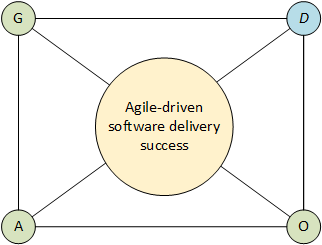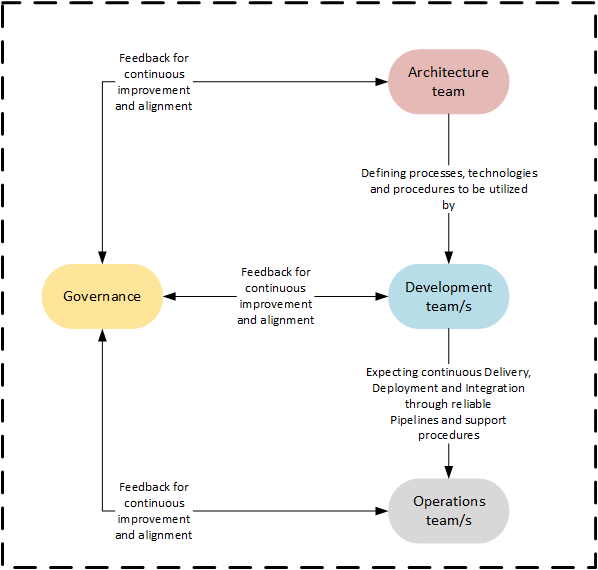
Evaluating AGILE adoption in software delivery organizations
Introduction
Software development methodologies play an important role in the organizations’ ability to respond to new stimuli originating from new requirements, features, vulnerabilities and bugs. AGILE methodologies are widely used, based on the premise of fast reaction and minimal expenditure in responding to these stimuli. Research in the field of AGILE is evaluated against (a) culture transformation (Gregory & Taylor, 2019), (b) projects, (c) frameworks (Dingsøyr et al., 2012; Diebold et al., 2018) or (d) specific IT functions. Table 1 demonstrates the extensive research undertaken in the evaluation of AGILE against specific IT functions. Software delivery organizations necessitate the use of the above functions in their overall software delivery success.
| Function | Literature |
| Development | Bianchi et al., 2020 Perkusich et al., 2020 Zaitsev et al. 2020 |
| Architecture | Beecham et al., 2021 |
| Project management | Bass & Haxby, 2019 |
| DevOps | Wiedemann, 2018 Hemon et al., 2019 Galup et al., 2020 Hemon-Hildgen et al. 2020 Wiedemann et al., 2020 |
| Security | Zaydi & Nassereddine, 2019 |
| Governance | Vejseli et al., 2018 Amorim et al., 2020 |
IT functions in AGILE teams
The below list explains the role of each IT function within the software development organization.
- Development (D) – The actual development teams.
- IT Governance (G) – The overall IT function which ensures that all IT functions are aligned and co-ordinated toward the organization’s IT strategy.
- Architecture (A) – The IT function responsible to leverage standardization, reduce complexity and maximizing efficiency and quality. The architecture function works closely with Product Owner, Project manager and development leads.
- Operations (O) – The IT function responsible to facilitate, enable, deliver and maintain software artefacts, produced by development teams. In today’s environments this is normally referred to as DEVOPS. Other IT functions can be included in this category including security (DEVSECOPS) and DATAOPS.
The IT Governance, Architecture and Operations functions are supporting agents to the development teams. Yet they are essential towards successful software delivery cycles. Based on the above, a logical model is presented in Figure 1 involving external (green) and internal (blue) agents affecting the success of agile software delivery. These agents are subject to unexpected and frequent changes (Dooley, 1997).

AGILE teams as Complex Adaptive Systems
The theoretical foundation enables the researcher to investigate the research problem. The Complex Adaptive Systems theory is suitable for such investigation since it evaluates the AGILE teams within the broader ecosystem. Agile teams are complex due to their characteristics, whereby every person has relationships and interaction and behavior is unpredictable (Alaa & Fitzgerald, 2013). Utilizing Ashby’s law of requisite variety, AGILE teams require internal capabilities to meet external requirements (Nerur & Balijepally, 2007). The study conducted by Jain and Meso (2004) demonstrate the lack of documentation produced by AGILE methodologies which can potentially compromise operations through refactoring, maintenance and support. Another issue related to AGILE methodologies is related to fast resolution of issues (software fixing; due to velocity-constraints the teams do not engage in adequate problem solving engagement (Nerur & Balijepally, 2007) thereby falling apart from architecture and governance paradigms. Figure 2 depicts AGILE-driven IT functions working in harmony within a complex system.

Validated instruments to measure the success of AGILE transformation
The instrumentation methods proposed in table 2 may be utilized to collect the necessary information from the appropriate IT functions. Such data allows researchers to evaluate the adoption and effectiveness of AGILE teams within the ecosystem.
| Instrumentation | Purpose | Reference |
| Strategic alignment maturity assessment | Measure adoption of governance, architecture, operations within the organization | Luftman, 2003 |
| DEVOPS assessment | Measure DEVOPS maturity within the organization | Gupta et al., 2017 |
| AGILE maturity model | Measure AGILE maturity within the organization | Gren et al., 2015 |
| AGILE transformation | Measure AGILE impact on software organization | Olszewska et al., 2016 |
Conclusion
The above research allows organizations to evaluate the agile adoption amongst all the IT functions, whereby the entire ecosystems is assessed and tuned accordingly. Such reality checks allow organizations to continuously improve their process and workforce towards improved software delivery cycles.
References
Alaa, G., & Fitzgerald, G. (2013). Re-Conceptualizing AGILE information systems development using complex adaptive systems. Emergence: Complexity & Organization, 15(3), 1-23. Retrieved January 9, 2022, from https://www.researchgate.net/profile/Ghada_Alaa/publication/258342063_Re-Conceptualizing_Agile_Information_Systems_Development_using_Complex_Adaptive_Systems_Theory/links/541952970cf203f155add9f7.pdf
Amorim, A. C., Mira da Silva, M., Pereira, R., & Gonçalves, M. (2020). Using AGILE methodologies for adopting COBIT. Information Systems, 101496. https://doi.org/10.1016/j.is.2020.101496
Bass, J. M., & Haxby, A. (2019). Tailoring product ownership in large-scale Agile projects: Managing scale, distance, and governance. IEEE Software, 36(2), 58–63. https://doi.org/10.1109/ms.2018.2885524
Beecham, S., Clear, T., Lal, R., & Noll, J. (2021). Do scaling agile frameworks address global software development risks? An empirical study. Journal of Systems and Software, 171, 110823. https://doi.org/10.1016/j.jss.2020.110823
Bianchi, M., Marzi, G., & Guerini, M. (2020). Agile, Stage-Gate and their combination: Exploring how they relate to performance in software development. Journal of Business Research, 110, 538–553. https://doi.org/10.1016/j.jbusres.2018.05.003
Buchmann, F., Nord, R. L., & Ozakaya, I. (2012). Architectural tactics to support rapid and agile stability. Carnegie-Mellon Univ Pittsburgh PA Software Engineering Inst.
Canat, M., Catala, N. P., Jourkovski, A., Petrov, S., Wellme, M., & Lagerstrom, R. (2018). Enterprise architecture and Agile development: Friends or foes? 2018 IEEE 22nd International Enterprise Distributed Object Computing Workshop (EDOCW). https://doi.org/10.1109/edocw.2018.00033
Chow, T., & Cao, D. (2008). A survey study of critical success factors in agile software projects. Journal of Systems and Software, 81(6), 961-971. https://doi.org/10.1016/j.jss.2007.08.020
Creswell, J. W., Creswell, J. D. (2018). Research design: Qualitative, quantitative, and mixed methods (5th ed.). Thousand Oaks, CA: Sage.
Diebold, P., Schmitt, A., & Theobald, S. (2018). Scaling Agile – How to Select the Most Appropriate Framework . Proceedings of the 19th International Conference on Agile Software Development Companion – XP ’18. https://doi.org/10.1145/3234152.3234177
Dingsøyr, T., Nerur, S., Balijepally, V., & Moe, N. B. (2012). A decade of agile methodologies: Towards explaining agile software development. Journal of Systems and Software, 85(6), 1213–1221. https://doi.org/10.1016/j.jss.2012.02.033
Dooley, K. J. (1997). A complex adaptive systems model of organization change. Nonlinear Dynamics, Psychology, and Life Sciences, 1(1), 69–97. https://doi.org/10.1023/a:1022375910940
Erder, M., & Pureur, P. (2016). What’s the architect’s role in an agile, cloud-centric world? IEEE Software, 33(5), 30-33. https://doi.org/10.1109/ms.2016.119
Gregory, P., & Taylor, K. (2019). Defining Agile culture: A collaborative and practitioner-led approach. 2019 IEEE/ACM 12th International Workshop on Cooperative and Human Aspects of Software Engineering (CHASE). https://doi.org/10.1109/chase.2019.00016
Galup, S., Dattero, R., & Quan, J. (2020). What do agile, lean, and ITIL mean to DevOps? Communications of the ACM, 63(10), 48–53. https://doi.org/10.1145/3372114
Gren, L., Torkar, R., & Feldt, R. (2015). The prospects of a quantitative measurement of agility: A validation study on an agile maturity model. Journal of Systems and Software, 107, 38-49. https://doi.org/10.1016/j.jss.2015.05.008
Gupta, V., Kapur, P., & Kumar, D. (2017). Modeling and measuring attributes influencing DevOps implementation in an enterprise using structural equation modeling. Information and Software Technology, 92, 75-91. https://doi.org/10.1016/j.infsof.2017.07.010
Hemon, A., Lyonnet, B., Rowe, F., & Fitzgerald, B. (2019). From Agile to DevOps: Smart skills and collaborations. Information Systems Frontiers, 22(4), 927–945. https://doi.org/10.1007/s10796-019-09905-1
Hemon-Hildgen, A., Rowe, F., & Monnier-Senicourt, L. (2020). Orchestrating automation and sharing in DevOps teams: A revelatory case of job satisfaction factors, risk and work conditions. European Journal of Information Systems, 29(5), 474–499. https://doi.org/10.1080/0960085x.2020.1782276
Jain, R., & Meso, P. (2004). Theory of complex adaptive systems and agile software development. AMCIS 2004 Proceedings, 197. RetrievedJanuary 9, 2022, from https://aisel.aisnet.org/cgi/viewcontent.cgi?article=1773&context=amcis2004
Johnson, B., Holness, K., Porter, W., & Hernandez, A. (2018). Complex adaptive systems of systems: A grounded theory approach. Grounded Theory Review, 7(1). RetrievedJanuary 9, 2022, from http://groundedtheoryreview.com/wp-content/uploads/2019/01/06-Johnson-Complex-GTR_Dec_2018.pdf
Luftman, J. (2003). Assessing IT: Business alignment. Information Systems Management, 20, 9-15. https://doi.org/10.1201/1078/43647.20.4.20030901/77287
Luna, A. J. H. de O., Kruchten, P., & Moura, H. P. de. (2015). The Conceptual Development Of The Agile Governance Theory. Information Systems and Technology Management 2, 177–201. https://doi.org/10.22533/at.ed.02919190312
Morrell, J. (2005). Complex adaptive systems. In S. Mathison (Ed.), Encyclopedia of evaluation, 72-72. Thousand Oaks, CA: SAGE Publications, Inc. https://doi.org/10.4135/9781412950558.n92
Nerur, S., & Balijepally, V. (2007). Theoretical reflections on agile development methodologies. Communications of the ACM, 50(3), 79–83. https://doi.org/10.1145/1226736.1226739
Olszewska, M., Heidenberg, J., Weijola, M., Mikkonen, K., & Porres, I. (2016). Quantitatively measuring a large-scale agile transformation. Journal of Systems and Software, 117, 258-273. https://doi.org/10.1016/j.jss.2016.03.029
Onix, M. F. A., Fielt, E., & Gable, G. G. (2017). Complex adaptive systems theory in information systems research: A systematic literature review. In Proceedings of the 21st Pacific Asia Conference on Information Systems (PACIS 2017). RetrievedJanuary 9, 2022, from http://aisel.aisnet.org/pacis2017/271
Perkusich, M., Chaves e Silva, L., Costa, A., Ramos, F., Saraiva, R., Freire, A., … Perkusich, A. (2020). Intelligent software engineering in the context of agile software development: A systematic literature review. Information and Software Technology, 119, 106241. https://doi.org/10.1016/j.infsof.2019.106241
Porter, C. (2017). An agile agenda wow CIOs can navigate the post-Agile era. RetrievedJanuary 9, 2022, from https://cdn2.hubspot.net/hubfs/2915542/White%20Papers/6point6-AnAgileAgenda-DXWP.2017.pdf
SCRUM Alliance. (2017). State of SCRUM 2017-2018 – Scaling and agile transformation. SCRUMalliance.org. RetrievedJanuary 9, 2022, from http://info.scrumalliance.org/rs/510-STH-507/images/2017-SoSR-Final%20Version_sm.pdf
Snyder, B., & Curtis, B. (2018). Using analytics to guide improvement during an Agile–DevOps transformation. IEEE Software, 35(1), 78–83. https://doi.org/10.1109/ms.2017.4541032
Vejseli, S., Proba, D., Rossmann, A., & Jung, R. (2018). The agile strategies in IT Governance: Towards a framework of agile IT Governance in the banking industry. In Twenty-Sixth European Conference on Information Systems (ECIS 2018). 1-17. University of Portsmouth.
Virmani, M. (2015). Understanding DevOps & bridging the gap from continuous integration to continuous delivery. Fifth International Conference on the Innovative Computing Technology (INTECH 2015). https://doi.org/10.1109/intech.2015.7173368
Vizard, M. (2020, May 29). Survey sees increased agile adoption during COVID-19. DevOps.Com. Retrieved January 9, 2022, from https://devops.com/survey-sees-increased-agile-adoption-during-covid-19/
Wiedemann, A. (2018). IT governance mechanisms for DevOps teams – How incumbent companies achieve competitive advantages. Proceedings of the 51st Hawaii International Conference on System Sciences. https://doi.org/10.24251/hicss.2018.617
Wiedemann, A., Wiesche, M., Gewald, H., & Krcmar, H. (2020). Understanding how DevOps aligns development and operations: A tripartite model of intra-IT alignment. European Journal of Information Systems, 29(5), 458–473. https://doi.org/10.1080/0960085x.2020.1782277
Woods, E. (2015). Aligning architecture work with agile teams. IEEE Software, 32(5), 24-26. https://doi.org/10.1109/ms.2015.119
Zaitsev, A., Gal, U., & Tan, B. (2020). Coordination artifacts in Agile software development. Information and Organization, 30(2), 100288. https://doi.org/10.1016/j.infoandorg.2020.100288
Zaydi, M., & Nassereddine, B. (2019). DevSecOps practices for an agile and secure IT service management. Journal of Management Information and Decision Sciences, 22(4), 527-540.